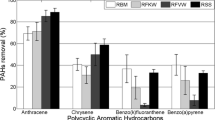Abstract
Composting technique was used for bioremediation of industrial soil originating from a former tar-contaminated site. The composting process was regulated by aeration to keep optimal temperature gradient and concentrations of O2 and CO2 inside the composting pile. The efficiency of bioremediation was evaluated by performing analysis of 11 individual three- to six-ring unsubstituted aromatic hydrocarbons (PAH) and estimating of changes in ecotoxicity of the contaminated soil. After 42 d of composting, PAH with 3–4 rings were removed from 42 to 68%, other higher-molar mass PAH from 35 to 57%. Additional 100 d of compost maturation in open-air field did not result in a further decrease of PAH. Ecotoxicity tests performed with bioluminescent bacteriaVibrio fischerii showed a decrease in toxicity both after composting and maturation phases. However, toxicity tests on mustard-seed germination did not reveal any significant changes during composting and maturation phases.
Similar content being viewed by others
References
Bhatt M., Cajthaml T., Šašek V.: Mycoremediation of PAH-contaminated soil.Folia Microbiol. 47, 255–258 (2002).
Fogarty A.W., Tuovinen O.H.: Microbiological degradation of pesticides in yard waste composting.Microbiol. Rev. 55, 225–233 (1991).
Guerin T.E.: The differential removal of aged polycyclic aromatic hydrocarbons from soil during bioremediation.Environ. Sci. Pollut. Res. 7, 19–26 (2000).
Kotterman M.J.J., Vis E.H., Field J.A.: Successive mineralization and detoxification of benzo[a]pyrene by the white-rot fungusBjerkandera sp. strain BOS55 and indigenous microflora.Appl. Environ. Microbiol. 64, 2853–2858 (1998).
Microtox Manual, Vol. 2. Detailed Protocols Microbics Corp., Carlsbad (CA) 1992a.
Microtox Manual, Vol. 3. Condensed Protocols. Microbics Corp., Carlsbad (CA) 1992b.
Potter C.L., Glaser J.A., Chang L.W., Meier J.R., Dosani M.A., Herrmann R.F.: Degradation of polynuclear aromatic hydrocarbons under bench-scale compost conditions.Environ. Sci. Technol. 33, 1717–1725 (1999).
Ritter W.F., Scarborough R.W.: A review of bioremediation of contaminated soils and groundwater.J. Environ. Sci. Health Pt.A Environ. Sci. Eng. 30, 333–357 (1995).
Semple K.T., Reid B.J., Fermor T.R.: Impact of composting strategies on the treatment of soils contaminated with organic pollutants.Environ. Pollut. 112, 269–283 (2001).
US EPA (US Environmental Protection Agency): Toxic substance control act test guidelines: environmental effects testing guidelines. Early seedling growth toxicity test.Fed. Registr. 50, 39393–39397 (1985).
Ziegenfuss P.S., Williams R.T., Myler C.A.: Hazardous material composting.J. Hazard. Mater. 28, 91–99 (1991).
Author information
Authors and Affiliations
Rights and permissions
About this article
Cite this article
Cajthaml, T., Bhatt, M., Šašek, V. et al. Bioremediation of PAH-contaminated soil by composting: A case study. Folia Microbiol 47, 696–700 (2002). https://doi.org/10.1007/BF02818674
Received:
Revised:
Issue Date:
DOI: https://doi.org/10.1007/BF02818674




